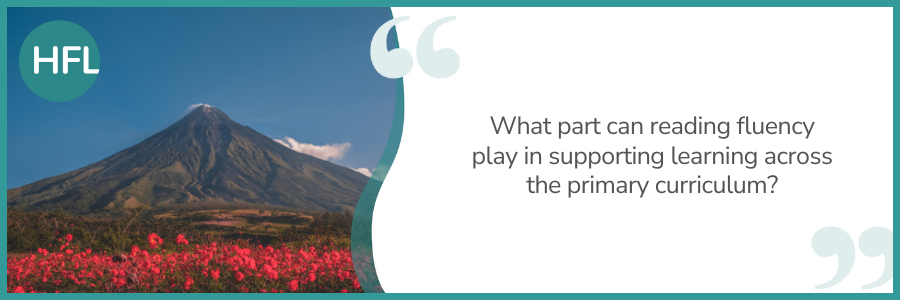
We rightly work hard in schools to develop competent readers and a reading for pleasure culture. Of course, reading is also a vital vehicle for learning across the curriculum and beyond.
Disciplinary reading at primary school
There’s growing interest in how disciplinary literacy can support children in their learning across the primary curriculum. Much of what has been published historically on the matter has – understandably - focused on secondary school disciplinary literacy. While teachers of science, geography or maths in the secondary phase know that they are teachers of reading too, disciplinary literacy lights the path to understanding how literacy truly underpins all subjects – not for the sake of improving literacy itself, but for a deeper, richer experience of the subject at hand. If a pupil can read with a view to identifying bias, drawing together information from a range of sources, identifying cause and effect, then they are on their way to becoming a better historian with the ‘tools’ required to make sense of the area they are studying.
More recently, work has been done on the roots of disciplinary literacy for the primary age range. This recent article from the EEF explored ‘Sowing the seeds of disciplinary literacy’, describing disciplinary literacy as ‘an integrated and powerful approach to explicitly and deliberately unlocking the knowledge and skills to support the branching out of curriculum domains.’
So, how can we teach children to read like historians, for example, when they are still in the early stages of learning to read? As primary teachers, we have the benefit of teaching children for all subjects, and can use our expertise to support children to use literacy to underpin learning more widely. In this blog, we will focus on reading.
The mutual benefit
Reading across the curriculum provides mutual benefits. Using reading in different subjects can deepen children’s ability to read in the style of a professional in the area, adopting the skills and tools required by a historian (for example) to construct meaning in the discipline (disciplinary literacy). It also enriches and deepens understanding in the subject at hand; children can learn about something by reading about it (known as content area reading). Research suggests that our brains learn well from stories, so dipping into the rich range of texts available (non-fiction, fiction and even poetry – as long as it supports the intended learning) has the potential to make learning memorable - not to mention, enjoyable - for pupils.
Of course, the other benefit is that it affords children the opportunity to flex their ‘reading muscles’, to apply their learning from English lessons in other contexts and broaden their all-important world knowledge by doing so. Could this be a win-win? Or a ‘two-fer’, as Dr Tim Rasinski coins it in our training.
Why is fluency important when reading across the curriculum?
For many of our younger children, content area reading is the starting point: using reading to learn about the content of the subject. We might read a fact-file about a habitat in KS1 science, or a biography of an artist in KS2 art. We might choose a wonderful story that captures a certain period of time. However, if we want children to truly learn the content that they are reading about, then they need to be able to read the text with an appropriate degree of automaticity. Without it, their brain will be focused on decoding the text in front of them, rather than making meaning of the content on the page. Whether it is content area reading or disciplinary reading we are after, what must come first to be successful, is the child being able to read the text with requisite fluency. It must feel automatic enough that the brain can turn its attention to making meaning. If not, the child will need the information presented in another way for the learning to take place, or be supported with strategies to access the text, so that the learning opportunity is not lost.
How might fluency instruction help to lighten the load?
We have seen the power of fluency instruction on pupil progress in accuracy and comprehension when reading. In our new course, Reading Fluency Across the Primary Curriculum, we work to harness fluency strategies to support learning across the curriculum, not instead of the learning of the subject at hand, but to underpin and enhance it.
Let’s imagine you are teaching a KS2 geography lesson, exploring what life is like for people living in the vicinity of a volcano. You are using some personal accounts from different people who live near a volcano as one of the sources of information that you want the children to analyse and interpret. The accounts will build on some of the substantive knowledge that children have about volcanoes and of Ecuador, the chosen location for study in the Americas. However, the task is also designed to make use of their disciplinary literacy, as they extract information, analyse and interpret it to make meaning as geographers. Of course, for the children’s focus to be on the geography learning at hand, the text must be carefully selected to ensure it is matched to the intended learning. (For the purposes of this blog, I have created this example - it is not from a genuine source.)
My name is Luis, and I run a small farm in the highlands near Cotopaxi, one of the tallest and most active volcanoes in Ecuador. Life here is centred around the land, and the fertile soil is a big part of why we choose to farm in this region. The ash from Cotopaxi’s past eruptions has enriched the soil, making it ideal for growing crops like potatoes, corn, and quinoa; our cattle graze on lush pastures, and we produce some of the best dairy products in the region. This fertile land is the foundation of our livelihood, and it's why my family has farmed here for generations.
However, living near Cotopaxi is not without its dangers. When the volcano becomes active, the threat of lahars—mudflows caused by volcanic ash mixing with glacial melt—is very real. These fast-moving flows can destroy everything in their path, and we’ve seen this happen in the past; the last time Cotopaxi erupted in a big way was 1877, but the stories from my grandparents still circulate. We’re always aware that the volcano could erupt again, and we prepare for it by having emergency plans in place. The government monitors Cotopaxi closely, and when it shows signs of activity, we receive an alert to evacuate if necessary.
Despite the risks, we remain because the land is so productive. The highland communities have learned to live with the volcano, and we work together to support each other during times of unrest. We keep our animals close to home when warnings are issued and store extra food and supplies. We’ve adapted to the rhythms of Cotopaxi, and as long as we stay prepared, we make it work.
In geography, information is likely to be presented in different forms: maps, photographs, tables, etc. The demands placed on many children in this context are high, as on top of reading and understanding, they are required to collate and analyse information from the range of sources. What can we do to help?
Read it more than once
Decades of research suggests that repeated reading has benefits for readers’ accuracy and automaticity, and in turn their comprehension, and we have certainly seen the benefits of this for pupils partaking in our Reading Fluency Project. If children are to comprehend the text in the lesson, and work with it in increasingly complex ways, then they need to be able to read it with enough automaticity for their brain to attend to the meaning. Reading a text more than once is an easy way to support this. You might pre-read the text with a group of children whose fluency could be a barrier to accessing the text, then in the lesson read the text to the whole class, before asking them to read it in pairs one more time before diving into the task at hand.
Something to consider when using repeated reading is how to motivate the pupils to read the text more than once. In his article, Why Reading Fluency Should be Hot, Dr Tim Rasinski talks about performance being powerful and authentic here; most of us would practise before presenting to an audience. In the case of the accounts of people living near a volcano, groups could prepare to read one of the accounts by practising it a couple of times, before reading aloud to the class with prosody. Then, open up a rich discussion about similarities, differences, and trends between the accounts, once all have been ‘performed’.
Plunder the vocabulary
There are some words in the account that will no doubt be key learning/content for this unit of work which capture the concepts being taught e.g. volcano, erupt, ash, active, fertile. In the account above, the children will come across them in that (all-important) context, helping them to develop a deeper sense of their meaning. For some words, you may just check for understanding. Others may need defining, exploring in context, and adding to your working wall. Looking more closely, though, there are words here which may not be familiar to the children but are likely to come up in other texts that they read. Understanding these could improve the children’s comprehension of the text in hand, and other texts too. Words such as foundation, generations, productive and prepared also require attention in this text. Here, you may use some different strategies that support children to make meaning of unfamiliar vocabulary in context. For example, you may use morphology to explore ‘productive’, linking to its root word ‘produce’ to unlock its meaning.
Look out too for polysemous words: words which have more than one meaning. Many curriculum subjects hold these words as our language is rich in them. Again, context is key here, so exploring the specific meaning of the words alert, foundation and active could prevent misconceptions. Making connections often helps. If we expect children to go on to use any of the key terminology in their writing or speaking about the topic, then they will need to become comfortable in its meaning.
Repeated reading and vocabulary exploration are just two of a broad range of strategies which can support children to access the text in front of them. As you introduce these strategies, children will become more confident with drawing on them independently when reading for meaning.
Using fluency strategies across the curriculum should not only build on pupils’ wider reading practice but, crucially, allow them to unlock learning across the curriculum.
Join us at our Reading Fluency Across the Curriculum online course to learn more about the research that underpins this work, and discover a huge range of strategies to use with your class.



